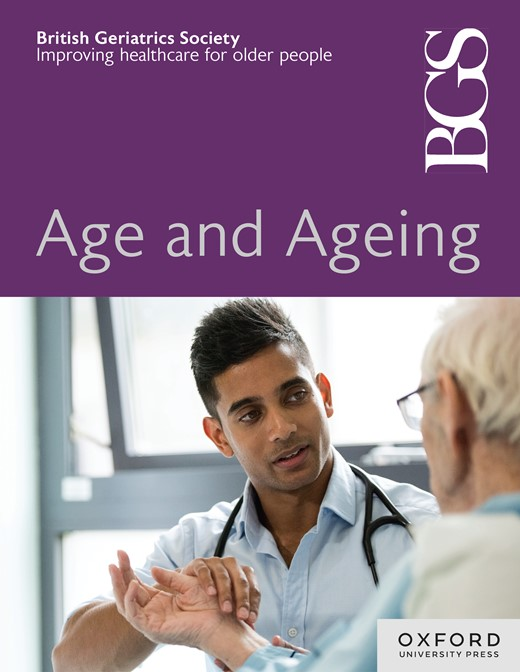受控超大强度高强度间歇训练对老年人肌肉能力和身体机能的影响:乌默奥 HIT 研究--随机对照试验的次要结果分析
IF 6
2区 医学
Q1 GERIATRICS & GERONTOLOGY
引用次数: 0
摘要
目的 本研究调查了超大强度高强度间歇训练(超大强度 HIT)与中等强度训练(MIT)相比对老年人肌肉能力和身体功能的影响。方法 对 68 名没有定期锻炼的老年人(66-79 岁,56% 为女性)随机进行为期 3 个月的每周两次超大强度 HIT(20 分钟,包括 10 × 6 秒间歇)或 MIT(40 分钟,包括 3 × 8 分钟间歇)训练。两组均在固定自行车上进行集体训练。目标强度由瓦特控制,采用标准化的速度和个性化的阻力。采用线性混合模型分析的结果包括腿部力量(诺丁汉力量仪)、手部握力(贾马测力计)、静态和动态平衡(单腿站立、30 秒台阶测试)、椅子站立(30 秒椅子站立)和无氧骑行成绩(改良博格自行车力量测试)。结果 基线值为(超极限 HIT/MIT,平均值 ± SD)腿部力量 198 ± 60/189 ± 53 W,手部握力 4.2 ± 1.0/4.3 ± 1.1 N/kg,静态平衡 64 ± 41/62 ± 41 秒,动态平衡 39 ± 7/38 ± 5 步,椅子站立 22 ± 6/22 ± 6,无氧骑行成绩 224 ± 60/217 ± 55 W。在 3 个月的随访中,观察到无氧骑车成绩的组间差异为 19[3;35] W,而超大负荷 HIT 的组间差异为[95% CI]。超极限 HIT/MIT 的组内平均变化为:腿部力量 8.4[0.9;15.8]/6.0[-1.3;13.3] W,手部握力 0.14[0.00;0.27]/0.13[-0.01;0.26] N/kg,静态平衡 11[3;20]/10[1;18] s,动态平衡 1.6[0.3;2.8]/2.3[1.1;3.6]步、2.1[1.1;3.1]/1.4[0.4;2.3]椅站立和无氧骑行成绩 31.3[19.6;43.0]/12.0[0.4;23.5] W。此外,研究结果表明,就对老年人肌肉能力和身体机能的影响而言,超极限 HIT 与 MIT 的益处相当。本文章由计算机程序翻译,如有差异,请以英文原文为准。
Effects of controlled supramaximal high-intensity interval training on muscle capacities and physical functions for older adults: analysis of secondary outcomes from the Umeå HIT study—a randomised controlled trial
Objective This study investigated the effectiveness of supramaximal high-intensity interval training (supramaximal HIT) on muscle capacities and physical function compared to moderate-intensity training (MIT) for older adults. Methods Sixty-eight older adults (66–79 years, 56% women), not engaged in regular exercise, were randomised to 3 months of twice-weekly supramaximal HIT (20 minutes including 10 × 6-second intervals) or MIT (40 minutes including 3 × 8-minute intervals). Both groups performed the training on stationary bicycles in a group setting. Target intensity was watt-controlled, with standardised cadence and individualised resistance. Outcomes analysed with linear-mixed models included leg power (Nottingham Power Rig), hand grip strength (Jamar dynamometer), static and dynamic balance (One leg stance, 30-second step test), chair stand (30-second chair stand), and anaerobic cycling performance (modified Borg Cycle Strength Test). Results Baseline values were (supramaximal HIT/MIT, mean ± SD) leg power 198 ± 60/189 ± 53 W, hand grip strength 4.2 ± 1.0/4.3 ± 1.1 N/kg, static balance 64 ± 41/62 ± 41 s, dynamic balance 39 ± 7/38 ± 5 steps, chair stands 22 ± 6/22 ± 6 and anaerobic cycling performance 224 ± 60/217 ± 55 W. At 3-month follow-up, a between-group difference in favour of supramaximal HIT [95% CI] was observed in anaerobic cycling performance of 19[3;35] W. Within-group mean changes for supramaximal HIT/MIT were for leg power 8.4[0.9;15.8]/6.0[−1.3;13.3] W, hand grip strength 0.14[0.00;0.27]/0.13[−0.01;0.26] N/kg, static balance 11[3;20]/10[1;18] s, dynamic balance 1.6[0.3;2.8]/2.3[1.1;3.6] steps, 2.1[1.1;3.1]/1.4[0.4;2.3] chair stands and anaerobic cycling performance 31.3[19.6;43.0]/12.0[0.4;23.5] W. Conclusion Supramaximal HIT showed superior effect on anaerobic cycling performance when compared to MIT. Additionally, the results indicate that supramaximal HIT is comparably beneficial as MIT in terms of effects on muscle capacity and physical function for older adults.
求助全文
通过发布文献求助,成功后即可免费获取论文全文。
去求助
来源期刊

Age and ageing
医学-老年医学
CiteScore
9.20
自引率
6.00%
发文量
796
审稿时长
4-8 weeks
期刊介绍:
Age and Ageing is an international journal publishing refereed original articles and commissioned reviews on geriatric medicine and gerontology. Its range includes research on ageing and clinical, epidemiological, and psychological aspects of later life.
 求助内容:
求助内容: 应助结果提醒方式:
应助结果提醒方式:


